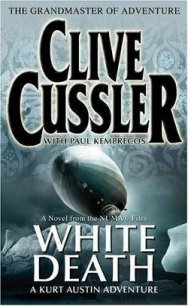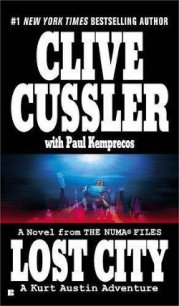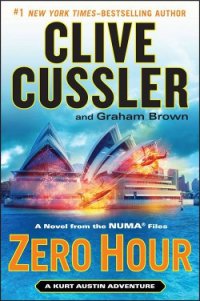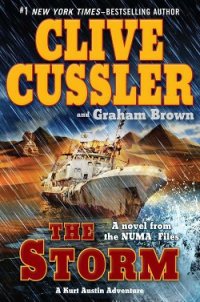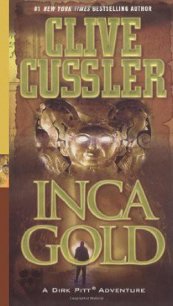The Navigator - Cussler Clive (читаем книги онлайн бесплатно полностью .TXT) 📗
“Solomon practiced motivational therapy as well,” Austin said. “Who better to trust than someone trying to make up for a past misdeed?”
“Solomon’s reputation for wisdom was well deserved. There are writing fragments on the papyrus that indicate Menelik was transporting a cargo of great value.”
“Nothing more specific?” Austin said.
“Unfortunately, no. The rest of the papyrus is basically a ship’s log. Menelik is the author, which means he must have been the captain. I found the word Scythians, repeated a couple of times. The Phoenicians often hired mercenaries to guard their ships. There is reference to a ‘GreatOcean,’ some weather observations, but the main part of the log is obscured by mold.”
“Now it’s your turn to cheer me up,” Austin said with a shake of his head.
“I think I can do that,” Saxon said. He pointed to several un-stained sections. “The roll was wrapped very tight here. The mold couldn’t get in. These lines describe a landfall. The captain talks about sailing into a long bay, almost like a small sea, where he could no longer smell the ocean.”
Austin came to attention. “The Chesapeake?”
“It’s a thought. The ship anchored near an island at the mouth of a wide river. He describes the water as more brown than blue.”
“I noticed the muddy quality of the water when we set out today,” Zavala said. “We passed an island near Aberdeen Proving Grounds.”
Austin still carried the Chesapeake Bay chart in a plastic map pouch. He unfolded the creases and spread the chart out on the floor. Borrowing a grease pencil from Saxon, he marked an X near Havre de Grace at the mouth of the Susquehanna. “We’ve got our Phoenicians cooling their heels here. What did they do with the cargo?”
“Maybe they hid it in a gold mine,” Saxon said.
“Your book suggested that Ophir was located in North America. Are you saying that this thing was hidden in King Solomon’s mine?”
“When I first started looking for Solomon’s mine, I concentrated on the area around the Chesapeake and Susquehanna,” Saxon said. “There was extensive gold mining within walking distance of Washington a hundred years before the big California Gold Rush of 1849.”
“We know that,” Austin said.
“Thelma Hutchins mentioned that her husband was aware of the gold mines,” Zavala said.
Saxon nodded. “There were more than a half dozen mines along the Potomac, from Georgetown past Great Falls, around the turn of the century. At least fifty mines operated in Maryland on both sides of the Chesapeake. The gold was found in rocks from the Piedmont Plateau, which runs from New York to South Carolina.”
“That’s a lot of territory to cover,” Austin said.
“Agreed. I started looking for evidence of Phoenician contact. I found it not in Maryland but farther north, in Pennsylvania. A cache of stones with Phoenician writing on them was discovered near the state capital at Harrisburg.”
“What sort of stones?” Austin said.
“A man named W. W. Strong collected around four hundred stones found near Mechanicsburg in the Susquehanna River valley. Dr. Strong interpreted the markings on them as Phoenician symbols. Barry Fell thinks the writing is Basque. Others say the markings are natural.”
“Hold that thought,” Austin said. He went out to the Jeep and returned with the stone he had retrieved from the wreck. Saxon’s jaw dropped to his Adam’s apple.
“Where on earth did you get that?”
“I brought it up from my dive on the shipwreck.”
“Astounding!” Saxon said. He took it from Austin, holding it as if it were made of glass, and traced the inscribed line with his finger. “This is Beth, the Phoenician symbol for house, later to evolve into the Greek B. It ties the wreck into Mechanicsburg.”
Austin drew a second X at the wreck site in the bay, and a third at the mouth of the river. He connected the Xs with a line and extended it up the river.
“The trail grows cold at Mechanicsburg,” he said.
“Not exactly. I’ve studied this area for years. Trekked a good deal of it on foot and by vehicle. If any location holds promise, it is this.” He drew a quick circle around an area north of Harrisburg. “St. Anthony’s Wilderness has always intrigued me because of the stories of a long-lost gold mine. There’s even a Gold Mine Road that runs through it. The area is rife with legends of abandoned towns and mining villages. It’s extremely rugged. It’s one of the few stretches of territory that hasn’t been developed.”
“Legends are one thing,” Austin said. “Facts are another.”
Saxon turned his attention back to the papyrus. “There’s an un-stained section here that has the only mention of a mine. The surrounding words have been blotted out by mold, except for a phrase that describes a horseshoe river turn.” Saxon’s long finger traced the river to a prominent U-shaped bend in the Susquehanna. “St. Anthony’s Wilderness is east of the bend.” He shook his head. “It’s a huge area. We could search for years without finding anything.”
Austin slipped a piece of paper from the chart pouch and placed it next to the map. A curving line on the paper matched the river bend on the map. Other squiggles denoted mountains and valleys to the east of the river. “This is a copy of a Phoenician map of Solomon’s mine. It was found with some Thomas Jefferson papers.”
“Jefferson? That doesn’t make any sense.”
“We’re hoping it will in time. What do you think of the map?”
Saxon read the Phoenician writing on the paper. “This shows exactly where the mine is in relation to the river.”
“Before we get too ecstatic, I have to point out a problem with this,” Austin said. “The Susquehanna is a mile wide and a foot deep, as the locals say. It’s studded with rapids and islands. There’s no way a ship of Tarshish could have made its way upriver.”
“But cargo could have come down,” Saxon said. “The river would have been deep enough for a boat to come down during the spring snowmelt.”
“Tricky, but possible with the right kind of boat,” Austin admitted.
“The right kind of boat was called a Susquehanna Ark,” Saxon said with a smile. “They started running them in the 1800s from Steuben County, New York, downriver to Port Deposit, Maryland. They were basically big pontoon rafts, seventy-five feet long and sixteen feet wide of beam. They came down in the spring flood tide as the snow melted, carrying produce to market. The arks would be dismantled, their lumber sold, and the crews walked home. It took eight days to float down and six to walk back. They carried millions of dollars in cargo before the railroads put them out of business.”
“A simple but brilliant concept,” Zavala said. “The Phoenicians could have used the same technique to transport gold.”
Saxon let out a hearty laugh. “Rider Haggard will be spinning in his grave. He and the rest of the world have assumed King Solomon’s mines were in Africa.”
Zavala had been looking at the maps. “I have a problem of my own. There’s a body of water covering the site pinpointed on the old map.”
Saxon’s eyes followed Zavala’s pointing finger. “So it is. That complicates matters.”
“Only a little bit,” Austin said. “I suggest we pull the Special Assignments Team together for a water-search operation tomorrow,” Austin said. “It’s a short hop to St. Anthony’s Wilderness by helicopter. We can be there first thing in the morning.”
“Splendid!” Saxon said. I’ll go over the papyrus again, and dig into my research, in case I’ve missed something.”
Austin pinched his chin between his thumb and forefinger. “Solomon went through a lot of trouble to hide this relic from mankind’s eyes.”
Zavala sensed the seriousness in his colleague’s voice. “I think you’re saying we may be grabbing a tiger by the tail.”
“In a manner of speaking. Let’s say we find this object. What do we do with it?”
